

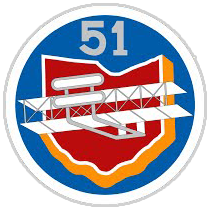 Description:
Description:
On an azure disc bordered argent, a Wright Flyer in Argent at the fess point is superimposed over a map of the state of Ohio. The map in Gules at the nombril point is trimmed in Argent. A Tenne depth is on the southern and eastern sides of the state’s trim. The undercarriage, wire bracing, struts, and edges of the forward horizontal elevator are silver-gray. The struts and supporting wire braces extend from the top or leading edge of the upper wing to the top or leading edge of the lower wing. At the middle chief are the Arabic numerals "51" in silver-gray.
Significance:
The map of Ohio signifies the home for the wing. The Wright Flyer pays homage to Orville and Wilbur Wright, natives of Dayton, Ohio who invented and constructed the world’s first successful airplane in 1903. The Flyer depicted is this airplane. The colors of azure, gules, and argent are representative of the colors of the Ohio state flag, as well as the colors of the Civil Air Patrol. Centered above the map of the state are the numerals "51" in silver-gray, for the Ohio Wing was the first state in the Army’s Fifth Service Corps area during World War II, as designated by Civil Air Patrol National Headquarters in Operations Directive No. 1, 12 February 1942.
History:
The Ohio Wing patch was approved by National CAP Headquarters on 20 October 1950. The original designer remains unknown.
Information provided by:
Colonel Frank A Blazich, Jr, Ohio Wing Historian


Description: Azure trimmed Or, Argent annulet charged torteau at fess point, Tenne trimmed Argent contrail extending dexter base to Argent delta at sinister chief, three Argent mullets of
four points at dexter chief, Argent scroll trimmed Or beneath base, Azure inscription "OHIO WING".
Significance: On a blue field, symbolic of the skies where CAP operates, rests a red disc surrounded by a white ring. Borrowed from the Ohio Burgee, this represents the "O" in "Ohio" with reference to both the state and planet Earth. In the upper left field are found three stars, representing the wing's (and Ohio’s) aviation past, present, and future. An orange contrail encircles the "O" and trails a white delta rising to the upper right of the blue field. As the birthplace of the Wright Brothers and heavier-than-air flight, together with no less than 25 astronauts, a delta represents aviation and space flight by men and women who have reached for the stars. The delta shape is reminiscent of the first orbital flight of Project Mercury, Friendship 7, flown by Ohio-native, Astronaut John Glenn, an honorary Ohio Wing member. In Project Apollo, another Ohio-native, Neil Armstrong, became the first human to walk on the surface of the moon. With the establishment of the U.S. Space Force, current and future Ohio Wing members will reach for the stars and beyond. Collectively, this is a design intended to bridge the wing's past with the tremendous potential of its future.
Designer: Col Frank A. Blazich, Jr., with graphic assistance from Lt Col Matt Johnson and
2nd Lt Karolyn Hasselfeld, approved 9 July 2021.
Information provided by:
Col Frank A. Blazich, Jr., National Historian
February 12, 2022

Description:
On a field of gules, the first generation Civil Air Patrol officers cap insignia is positioned on the center base, with the national Civil Air Patrol crest in azure, gules, and argent at the nombril point. The argent wings sweep upwards, with argent estoites at the dexter and sinister chief positions, flanking an argent arabic "1" at the middle chief, all within a border of Or. Below the field of gules, an argent scroll with letters of azure reads "OHIO WING HEADQUARTERS" within a border of Or.
Significance:
The first generation Civil Air Patrol officers cap insignia is symbolic of the wing's heritage and founding under the command of Colonel Earle L Johnson in September 1941. The twin stars symbolize the squadron's leadership component and dual relationships with state government of Ohio and the United States Air Force. The argent color represents the qualities of perfection and wisdom which the wing staff strives to imbue upon the members of the Ohio Wing. The gules field represents the patriotism and strength of the collective membership of the squadron. The number "1" represents the squadron's unit designation number.
History:
Emblem designed by Major Frank Blazich in November 2011.
Information provided by:
Major Frank A Blazich, Jr, Ohio Wing
February 9, 2014

Description:
Upon a shield of Azure bordered in Or perch outstretched Argent wings at the middle base, reaching to the dexter and sinister chiefs, with an Argent triangle with a three-bladed propeller in Gules centers at the middle chief. At the nombril point rests a fighting knife with an Argent blade and Or hilt and pommel. Extending from the dexter to the sinister base are six Argent mullets, three flanking each side of the knife blade. At the far reaches of the dexter and sinister chiefs are the inscriptions in Argent characters "CAP", while a scroll of Gules trimmed in OR beneath the shield bears the inscription in Argent "SQUADRON GLR-OH-032".
Significance:
The six stars represent the wings of the Great Lakes Region. A fighting knife is symbolic of the "cutting edge" response time, strength in mission, and contribution of the Civil Air Patrol from World War II to the present day. Outstretched silver wings signify the CAP's role as the United States Air Force Auxiliary and its commitment to aerospace education, guardianship and oversight of the civilian aviation community. A border of gold stands for excellence, blue for the USAF, and the red scroll for the passion and call to action which the members of the squadron all share.
History:
Emblem designed by Christopher A Fussner in July 2005.
Information provided by:
Major Frank A Blazich, Jr, Ohio Wing
February 9, 2014


Description:
A downy woodpecker, indigenous to the area served by Group VII, in full flight over the territory nurtured by the Mad, Little Miami, Stillwater and Lost Rivers which converged to form the Big Miami River. The bird is wearing earphones, a Mae West jacket and carries a camera and first aid kit. On its head is an academic mortar board cap and clutched in its talons is a pair of dice displaying the numerals three and four.
Significance:
The mission of Group VII is symbolized by the life jacket and the first-aid kit representing rescue; the camera denotes reconnaissance; the ear phones suggest communications and the mortar board brings to mind the group’s mission to instruct the youth of its area in aviation careers so necessary to the well-being of the country. The dice showing the total number seven are not merely the unit’s designation, but signify the good luck wished them by the community from which the members of the group are drawn. Not only because the Downy Woodpecker is native to Group VII’s geographical location, but because he is a small bird, symbolic of the light aircraft operated by the members, he is shown here in an attitude of cheerful service to the community over which he flies. The Downy Woodpecker is a great friend both to farmers and city dwellers, but an enemy of all insect life which destroys crops and mars the tree-shaded beauty of urban areas. So it is with the mission of Group VII. The joining of the rivers indicated on the terrain further symbolizes the concerning unity of individual squadrons of the section which merged to form Group VII of the Ohio Wing. The green earth is indicative of the native soil the members of this organization are determined to protect and preserve.
History:
Designed by Milton Caniff, July 9, 1956 [original artwork]. The description and significance above is taken directly from Caniff's release for the insignia. The modern patch (Version 3) does not feature all of the listed elements.
Information provided by:
Group 7 Headquarters
July 10, 2020

Description:
At the fess point an argent eagle clasping direction finding equipment and superimposed upon a diagonal gules bar dives to the dexter base. The predominantly vert sinister base area contains three sable squares. The azure dexter chief has an argent stylized "051" composed entirely of right angles and parallel lines at the base. The azure scroll beneath the primary field contains the words "YOUNGSTOWN WARREN" in argent, within a sable border.
Significance:
The diving eagle clasping direction finding equipment in its beak and talons symbolizes fast, professional response in order to save lives. The sinster base area with the three squares, representing the three missions of the Civil Air Patrol, as well as membership in Group III of the Ohio Wing, further symbolizes the ground and the unit's primary area of operations. The azure dexter represents the sky and the parent organization of the United States Air Force. An argent "051", with the "0" bordering the "51" composed of right angles and parallel lines symbolizes the unit's charter number and drive for sustained professionalism, excellence, and precision. The words "Youngstown" and "Warren" denote the two major metropolitan areas composing the membership of the unit. Historically, it stands for the Youngstown Composite Squadron and the Warren Composite Squadron whose members joined together to form our modern unit.
History:
Emblem designed by by William Hrinko in 2004.
Information provided by:
Major Frank A Blazich, Jr, Ohio Wing
February 9, 2014

Description:
A field of Argent, trimmed in Or, with an Azure outline of the state of Ohio resting at the fess point, with the Gules inscription "GROUP" and "VI" at the middle chief and middle base, with a scroll of Argent with an Or border bearing the inscription in Azure "CIVIL AIR PATROL".
Significance:
The blue and yellow are represenlative of the United States Air Force, while the collective colors of red, white, and blue emulate the colors of the Civil Air Patrol. An outline of the state of Ohio symbolizes the group's connection to the Ohio Wing. A field of white, for the wisdom of the group leadership, and the red text calls forth the strength and magnanimity of the leadership.
History:
Emblem designed by William L Kidney in December 1988.
Information provided by:
Major Frank A Blazich, Jr, Ohio Wing
February 9, 2014

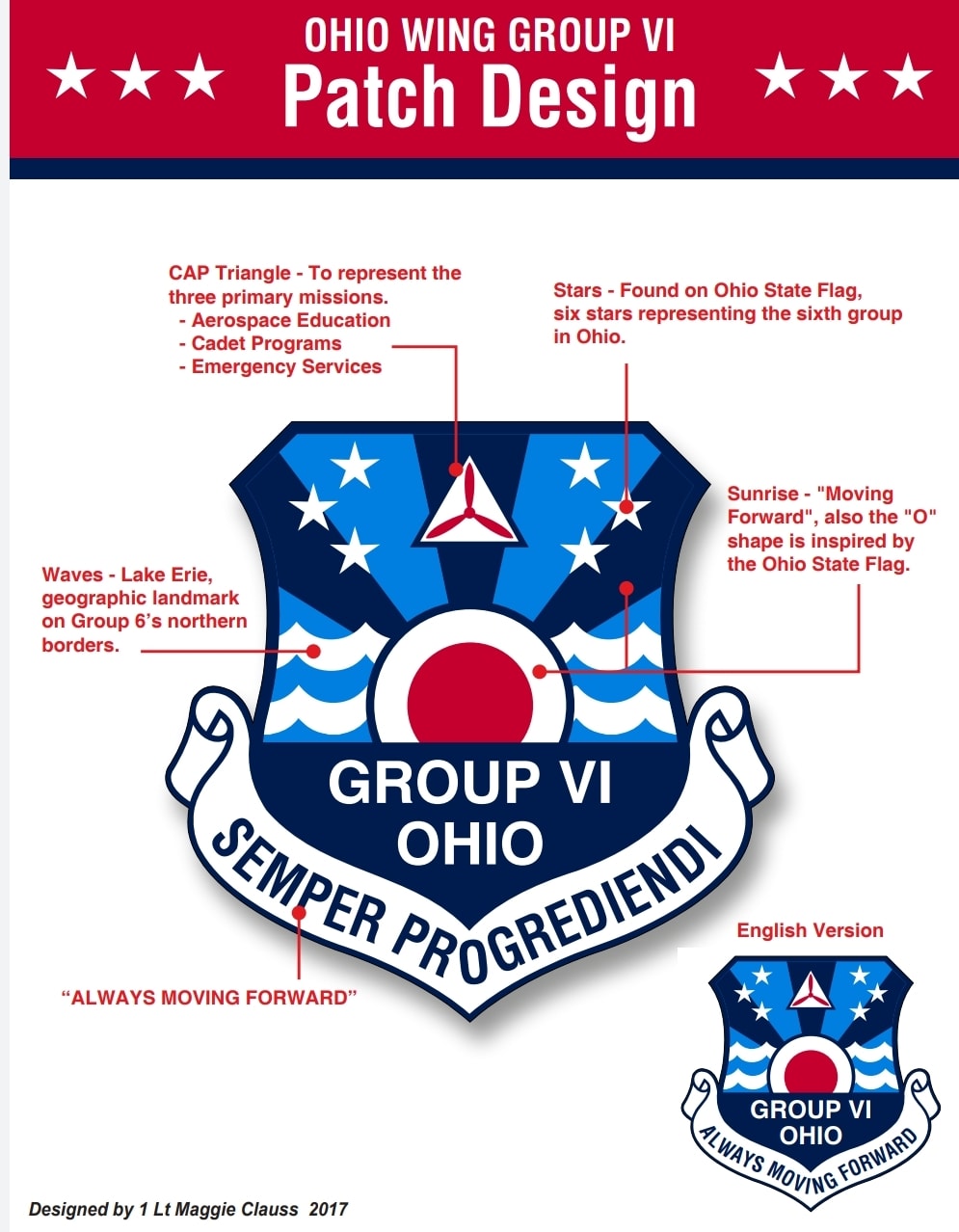
Information provided by:
Maj Sean M Beck, Group Commander
September 28, 2017

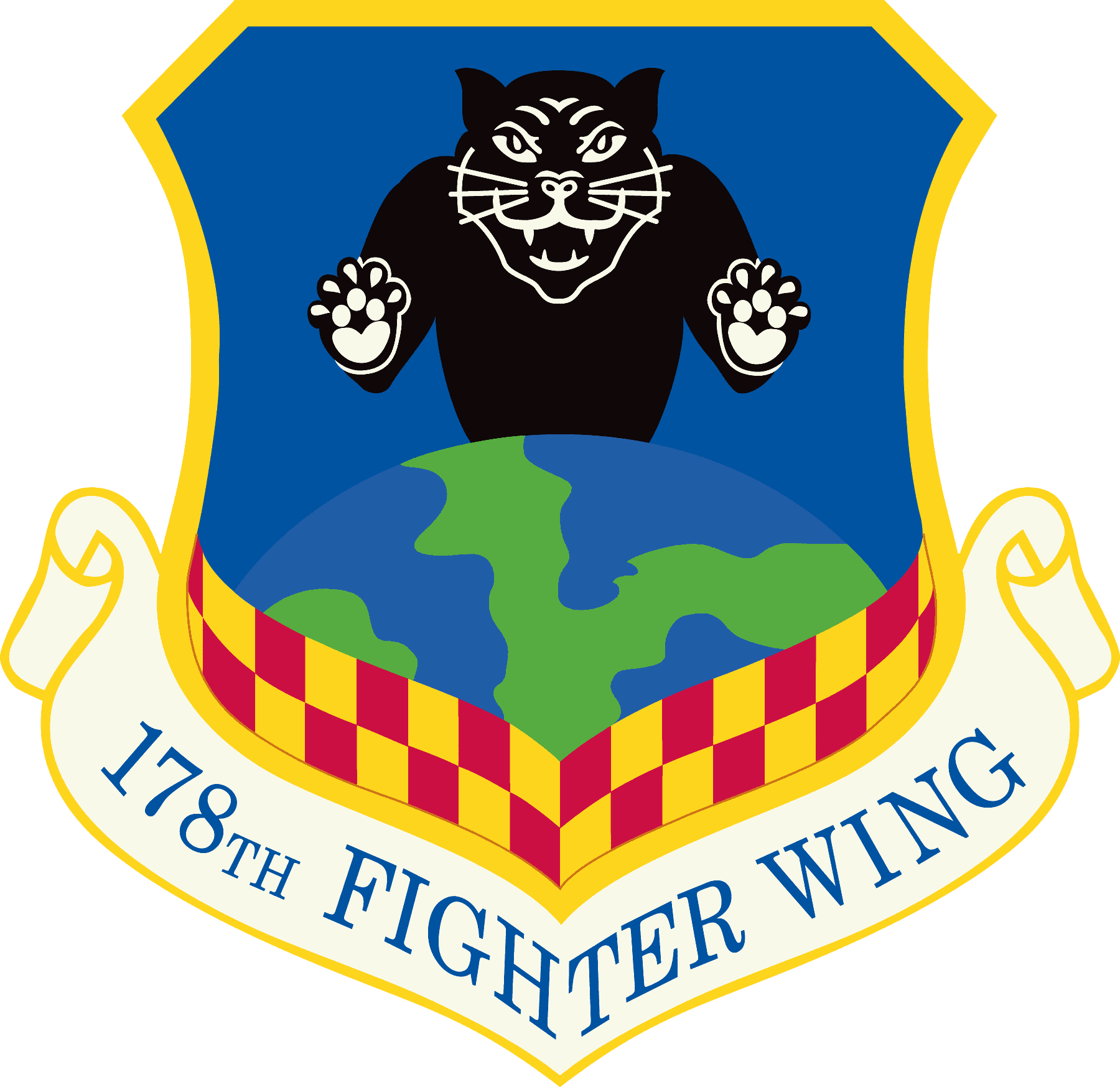 A roundle with upper and lower scrolls and a bordure. The roundle is a solid field of red with a salient panther facing guardantly whose chest is emblazoned with the numerals 702, wings displayed and elevated pointing chiefly, and a Civil Air Patrol emblem resting on the honor point.
A roundle with upper and lower scrolls and a bordure. The roundle is a solid field of red with a salient panther facing guardantly whose chest is emblazoned with the numerals 702, wings displayed and elevated pointing chiefly, and a Civil Air Patrol emblem resting on the honor point.
The solid red field represents courage and patriotism, qualities embodied by cadets.
The panther represents the squadron's geographic location and relationship with the Springfield Air National Guard Base, sharing the charge with the 178th Fighter Wing. The panther, though fierce, is tender and loving to its young and will defend them with the hazard of its own life. So to, the squadron teaches its cadets the qualities of selflessness and courage.
The numerals 702 respresent the squadron's numerical disignation.
The white wings represent swiftness and protection, qualities indicative of the squadron's emergency sevices mission.
The Civil Air Patrol emblem is a three-bladed propeller in the civil defense white-triangle-in-blue-circle, representing the squadron's service affiliation and the three missions of the Civil Air Patrol which are emergency services, aerospace education and the cadet program.
The upper scroll is a solid field of blue with the motto "That Others May Live". The blue field represents loyalty and truth, qualities sworn to in the Cadet Oath and Honor Code. The motto represents the squadron's search and rescue mission, pledging to save the lives of others.
The lower scroll contains the squadron's name "Ross P. Barrett Cadet Squadron" honoring the Springfield-area community leader and educator who served with distinction in WWII and the Korean War, and devoted much of his life to the service of the Civil Air Patrol.
The gold bordure represents generosity; a quality exemplified by the squadron's voluntary service to the Nation and community.
Information provided by:
2d Lt Tad "Ace" S Speary, Ross P Barrett Cadet Sq 702
March 26, 2010

 Description:
Description:
Surrounded by a border of Sable, on a field of Vert, with Azure extending from the dexter to the sinister base overall, an Argent gauntlet at the fess point wields an Or lightning bolt, extending from the sinister to the dexter chief. Two smaller Or bolts on the dexter flank the larger bolt. At the chief, the word "CINCINNATI" in Sable and at the middle base the Arabic "078" in Or. An Argent scroll below the base contains the words in Sable "SEMPER VIGILANS".
Significance:
The words "Cincinnati" and the numbers "078" represent the squadron's location and unit designation number. The blue and green background colors adjacent to each other represent the squadron's location along the Ohio River. The Latin Semper Vigilans references the Civil Air Patrol's motto for "Always Vigilant." The jigsaw pattern is emblematic of a similar pattern in many United States Air Force command patches and represents the close relation of the Air Force with the Civil Air Patrol. Lastly, the armored gauntlet grasping a lightning bolt with two smaller bolts has dual meanings: The gauntlet with the bolt represents the unit's Emergency Services Ground Team and Aircrew and their rapid response to emergencies. The three lightning bolts collectively represent the three missions of Civil Air Patrol: emergency services, cadet programs, and aerospace education.
History:
Designed by Eric Reiman, April 14, 2008. In use until March 2023.
Information provided by:
Major Frank A Blazich, Jr, Ohio Wing
February 9, 2014

Description:
On a disc of Azure and Tenne, three stars of Argent, the largest one at chief, with two smaller stars at dexter and sinister, overall in base a grid in Argent behind an eagle in profile in Sable detailed in Argent and Or, surrounded by a counter-compony in Gules and Argent all within a narrow border Black. Attached above the disc, an Orange scroll edged with a narrow Black border and inscribed "FORTUNA PARATIS FAVET", in Black letters. Attached below the disc an Orange scroll edged with a narrow Black border and inscribed "COLUMBUS OH-085" in Black letters.
Significance:
The background of the disc displays a graphic representation of an aircraft "attitude indicator" similar to that of the Garmin G1000 avionics and symbolizes our unit's status as the first squadron in Ohio to have custody of a Garmin G1000 equipped aircraft. Blue alludes to the sky, the primary area of operations for the squadron. Orange symbolizes strength and endurance. The silver lines on the orange field depict latitude and longitude "grids" that are often used in conducting our air missions. The horizon line is slanted so as to represent a climbing right turn, symbolic of the "right attitude" required of each squadron member, which is at the heart of volunteer service. The three stars represent the primary missions of the Civil Air Patrol: Cadet Programs, Aerospace Education, and Emergency Services. The larger star represents emergency services operations, centered, as the focus of our squadron. The eagle - symbol of nobility and courage - is featured flying in the direction of the wearer's right, symbolizing the "right" course or direction. The counter company design is of contrasting colors: red for patriotism and strength, and white for perfection and purity.
The squadron's motto, "Fortuna Paratis Favet", is Latin for "Fortune Favors the Prepared". This phrase conveys the heart of our squadron mission: to be safe in all activities, to be effective in our task, and to have fun while doiog it.
Information provided by:
Major Frank A Blazich, Jr, Ohio Wing
February 9, 2014

Description:
Surrounded by a border of or, with a two-color background of azure (sinister chief) and gules (dexter base), bisected from dexter-chief to sinister. In the dexter field is a two-color globe of sable and argent. At the base is an argent scroll below the base contains the phrase "READY DAY OR NIGHT" in sable. In the dexter base are the Arabic characters "96TH". From the base to the sinister field stands a tenne dog with a headset figure. In the sinister chief there are argent lightning bolts emanating from the dogs raised tail.
Significance:
As the 96th was one of the key ground Search and Rescue (SAR) units in Ohio, the nickname of the unit was the SAR Dogs. The motto "Ready Day or Night" relates to the squadron's ability to be deployed in any environment. The globe represents both day and night. The dog is the same character created by Walt Disney for Civil Air Patrol for Emergency Services. This also references the SAR Dog nickname as he is sniffing the ground in search of something, plus wearing a headset and picking up a transmission via his tail, alluding to receiving an ELT signal from a downed aircraft.
History:
Emblem designed by Christopher Smith and William Krause in 1998.
Information provided by:
Major Frank A Blazich, Jr, Ohio Wing
February 9, 2014

 Description:
Description:
Four elements rest on a dexter of Azure and sinister of Argent. At the dexter chief, Azure wings of the United States Air Force with a crest bearing a three-bladed propeller in Gules, and a Tenne bolt of lightning at the dexter base. At the sinister chief rests a silhouette of an aircraft, trimmed in Sable, with Argent, Azure, and Gules accents. A Gules cross rests upon the sinister base. Trimmed in Sable, an Argent scroll wraps the field beneath the base, with the inscription " COLUMBUS CADET SQUADRON" in Azure.
Significance:
The blue represents loyalty and the gray represents wisdom. The Civil Air Patrol propeller with United States Air Force wings represents the squadron's roots in the Air Force and the squadron's cadet programs. Aerospace programs are represented by the Civil Air Patrol aircraft. The lightning bolt is emblematic of swiftness, and the red cross symbolizes the squadron's emergency services work.
History:
Embem designed by Justin Baier, Tim Miller, and Dan Schoessler in 2007.
Information provided by:
Major Frank A Blazich, Jr, Ohio Wing
February 9, 2014

 Symbolism:
Symbolism:
The updated squadron patch design incorporates many characteristics of the previous squadron patch but has been updated to follow current Air Force and Civil Air Patrol heraldry guidelines. The lower portion of the patch is blue to signify our loyalty to CAP, the Air Force, and the United States. In the field of blue are the United States Air Force wings with a CAP propeller in the center. The wings represent our roots in the United States Air Force and the propeller represents the Cadet Program. Combined, they also represent our partnership with the total force. The upper portion of the patch is gray, representing our humility. The three red arrows represent our commitment to the three missions of CAP (Cadet Programs, Emergency Services, and Aerospace Education). The arrows are red to represent valor and our commitment to the emergency services program. Separating the fields of blue and gray is a lightning bolt with two slashes. The first slash represents our swiftness when called to action. The second slash represents our commitment to cyber programs. The lightning bolt is yellow to represent honor. Our squadron motto, With Honor We Serve, is in the top scroll, while our squadron name is in the bottom scroll.
History:
Emblem designed by C/Capt David Reid, C/2d Lt Cayden Smith, and Maj Matt Rittenhouse (Project Advisor) between 2019-2020.
Information provided by:
Maj Kyle Yanak, Squadron Commander
August 9, 2020

Description:
Brown trimmed Sable, Tenne phoenix displayed, Azure, Argent, Gules disc at base, Sable edged with Brown inscription "156" at middle chief, Brown scroll trimmed in Sable, beneath base, Argent inscription "WARREN CO. CADET SQ."
Significance:
A phoenix rising from the flames is representative of the squadron’s move from the Warren County Airport to Mason, Ohio and its rebirth during the transition from Squadron 106 to its present GLR-OH-156. The bold numbers "156" stand for the unit’s numerical designation and the Civil Air Patrol’s original World War II insignia identifies not only the squadron’s affiliation, but also the past connection of the squadron to Warren County, Ohio.
History:
Designed by a team led by Tyler Stewart in January 2013.
Information provided by:
Major Frank A Blazich, Jr, Ohio Wing
February 9, 2014


"I returned to the unit in 2005 after 11 years in other units, and the then-commander, Captain Jim Woodard, had a unit patch in progress. He had somehow arranged to have an art student at the Medina County Career Center make him some choices. What that student came up with is attached and inserted below." [at right]
"This patch was initially rejected because of its shield design and a change in CAP regulations that, I believe, now require a circular design for unit patches. While I'm not an artist per se, in my job in video production at the time I was a regular user of Photoshop and he asked if there was anything I could do to take the shield and make it a circle. The patch you have is the result. The "hawk" is obviously a reference to the "Skyhawks" name, and the three-bladed propeller, white triangle, and blue background represent CAP and our three missions. The placement of the Hawk in the foreground and the CAP propeller gives the image some depth and is just because I thought it would look good. The deep red outline to the patch was of my choosing and is simply because I thought it looked good and off-set the rest of the patch. The yellow "Medina County Skyhawks" again has no meaning outside the obvious and was chosen because it stood out for ease of reading and was the more accurate name of the unit. The most up to date version of the patch, which I do not have a copy of, has in small black alphanumerics, "OH-219" in the small area of blue below the Hawk's beak, which is our charter number, and was added by a later unit commander, now Major Jason Kauffmann."
"That's all I know about the history of the unit patch for the Medina County Skyhawks, OH-219."
Information provided by:
Lt Col Steven D Stein, CAP (ret)
Medina County Skyhawks (1989-1994, 2005-2010)
November 13, 2014

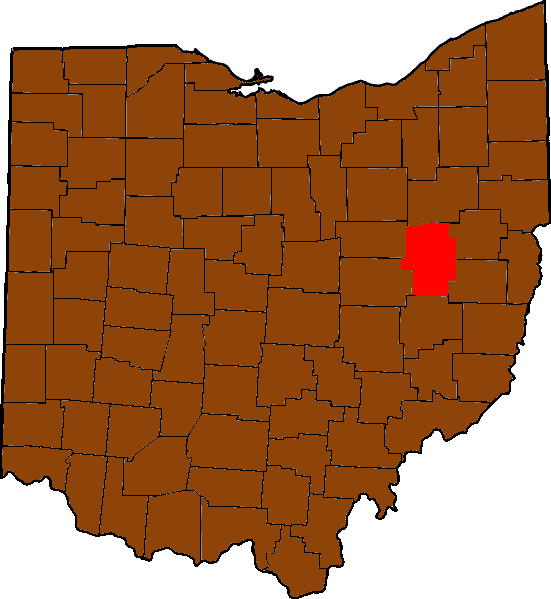
The emblem was designed by Deputy Commander for Cadets, Captain James R Wilson. The design was approved by Squadron Commander, Lieutenant Colonel Marilyne E Shanks, and authorized as a wearable patch by Ohio Wing Commander, Colonel Dave Winters in mid-October 2010.
Information provided by:
Captain James R Wilson
Tusco Composite Squadron
November 9, 2010

Description:
Party per bend Gules thunderbolt Azure checky Or and Sable, Pegasus salient contourné , Argent trimmed Sable, Agent and Gules triangle at dexter, Argent inscription "279" at the base, Argent scroll trimmed Sable beneath base, Sable inscription "CLERMONT COUNTY".
Significance:
The flying horse symbolizes the unit’s moniker, the Flying Mustang. The mustang’s rise toward the gold and black of the checkerboard pattern represents the journey toward humility, honor and wisdom while the silver of the horse is indicative of purity during the journey. The gold and black checkerboard pattern mimics the paint pattern on the aircraft "Cincinnati Miss", a P-51 Mustang acting as the representative aircraft of the Tri-State Warbird Museum located at the Clermont County Airport, the home of the squadron. A red lightning bolt stands for the rapid response of the unit to crisis and the strength and courage it takes to face adversity. An ultramarine blue background signifies the sky where the Civil Air Patrol was born and the squadron’s relationship with the United States Air Force. A white triangle with a red, three-bladed propeller represents the Civil Air Patrol and its three primary missions: aerospace education, cadet programs and emergency services. The words "Clermont County" and the numerals "279" represent the location and unit designation of the squadron, respectively.
History:
Designed by Kevin Ryan in February 2013.
Information provided by:
Major Frank A Blazich, Jr, Ohio Wing
February 9, 2014

Description:
Vert per bend Vert Sable thunderbolt trimmed Sable, Brown Ohio trimmed Sable, U.S. Army Pathfinder’s badge in Or, Sable, Argent, and Gules at sinister chief, Sable and Gules star-and-cross at dexter base, Sable inscription "FIRST THERE" at chief, scroll beneath base, Sable inscription "288TH PATHFINDERS CADET SQUADRON".
Significance:
A lightning bolt bisecting the shield symbolizes the rapid response of the squadron in the event of any emergency. The outline of the State of Ohio represents the home of the squadron, with the exact location marked with map star and a superimposed red cross. This combination symbol encompasses the first aid and land navigation skills of the squadron membership. A U.S. Army Pathfinder’s badge, a winged torch, is a visual representation of the unit’s moniker as "Pathfinders" and the unit motto of "First There."
History:
Designed by Richard Fugate, Steven Fugate and Scott Fugate, October-December 2008.
Information provided by:
Major Frank A Blazich, Jr, Ohio Wing
February 9, 2014

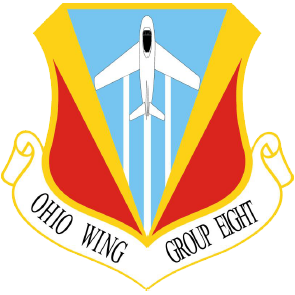 Description:
Description:
Gules, Or chaussé, Azure pile, Argent and Sable F-86 Sabre jet displayed with Argent contrails rising, Argent scroll trimmed Or beneath base, Sable inscription "OHIO WING GROUP EIGHT".
Significance:
The golden "V" and three parallel contrails signify the Roman number of VIII for the group’s designation. The red - yellow - blue colors are representative of the colors of the flag for the City of Columbus, Ohio, home of the group headquarters. Furthermore, the aquamarine blue is representative of the sky and the United States Air Force who the group’s squadrons serve and assist and where its members operate and safeguard. The F-86 Sabre is an additional nod to the location of the group headquarters, but also the aviation heritage of Columbus, as North American Aviation assembled the jet fighter at Port Columbus International Airport in the early 1950s. Flanking fields of red trimmed in gold are themselves symbolic of a pair of hands releasing the Civil Air Patrol squadrons under its guidance and command forth to serve the citizens of central Ohio. The colors are emblematic of the passion, patriotism, zeal, honor, and wisdom of the leadership of Group 8.
History:
Designed by Major Frank Blazich in February 2013.
Information provided by:
Major Frank A Blazich, Jr, Ohio Wing
February 9, 2014